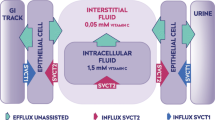Abstract
We have investigated the hypothesis that a lipid-soluble derivative of ascorbic acid, ascorbyl-6-palmitate (AP), could serve as a carrier of ascorbate into neural tissues. Ascorbate could then exert its physiological effects in the biomembranes that are the target sites of the cellular signaling pathways which are normally hardly accessible to this water-soluble compound. The potential role of AP would require that it penetrates into tissues. The major objective of the study was to determine whether ascorbate could be recovered from cerebral cortex and carotid body tissues, both sensitive to the hypoxic stimulus, after AP given by gavage. Biological samples were analyzed by HPLC for the determination of ascorbate. We found that ascorbate was recovered from the tissues studied. Its content was higher in both tissues, by nearly an order of magnitude, after ingestion of AP than after ingestion of ascorbic acid, and the ascorbate level was higher in the carotid body than in the cortex. Hypoxia decreased the ascorbate content which implies physiological activity of ascorbate carried alongside the AP molecule. The lipophilic AP was able to cross biological barriers and satisfied the tissue demand for ascorbate better than the hydrophilic form. AP should be considered as the preferred form of transport of ascorbate into neural tissues. The results of this study suggest wider pharmacological applications of ascorbyl palmitate.
Similar content being viewed by others
References
Agus DB, Gambhir SS, Pardridge WM, Spielholz C, Baselga J, Vera JC, Golde DW. Vitamin C crosses the blood-brain barrier in the oxidized form through the glucose transporter. J Clin Invest 100:2842–2848;1997.
Austria R, Semenzato A, Bettero A. Stability of vitamin C derivatives in solution and topical formulations. J Pharm Biomed Anal 15:795–801;1996.
Baader WJ, Hatzelmann A, Ullrich V. The suppression of granulocyte functions by lipophilic antioxidants. Biochem Pharmacol 37:1089–1098;1988.
Baardseth P. Effect of selected antioxidants on the stability of dehydrated mashed potatoes. Food Addit Contam 6:201–207;1999.
Chatterjee IB. Evolution and the biosynthesis of ascorbic acid. Science 182:1271–1272;1973.
De Ritter E, Cohen N, Rubin SH. Physiological availability of dehydro-L-ascorbic acid and palmitoyl-L-ascorbic acid. Science 113:628–631;1951.
Friedman PA, Zeidel ML. Victory at C. Nat Med 5:620–621;1999.
Harrison DC, Lemasters JJ, Herman B. A pH-dependent phospholipase A2 contributes to loss of plasma membrane integrity during chemical hypoxia in rat hepatocytes. Biochem Biophys Res Commun 174:654–659;1991.
Hirsch HE, Wernicke JF, Myers LW, Parks ME. Acid lipase-esterase (4-methylumbelliferyl oleate hydrolase) of white matter localized in oligodendrocyte cell bodies. J Neurochem 29:979–985;1977.
Horning D. Distribution of ascorbic acid, metabolites and analogues in man and animals. Ann NY Acad Sci 258:103–118;1975.
Lahiri S, Acker H. Redox-dependent binding of CO to heme protein controls PO2-sensitive chemoreceptor discharge of the rat carotid body. Respir Physiol 115:169–177;1999.
May JM, Qu ZC, Cobb CE. Accessibility and reactivity of ascorbate 6-palmitate bound to erythrocyte membranes. Free Radic Biol Med 21:471–480;1996.
Mitra A, Ravikumar VC, Bourn WM, Bourcier DR. Influence of ascorbic acid esters on acetaminophen-induced hepatotoxicity in mice. Toxicol Lett 44:39–46;1988.
Perricone N, Nagy K, Horvath F, Dajko G, Uray I, Nagy IZ. The hydroxyl free radical reactions of ascorbyl palmitate as measured in various in vitro models. Biochem Biophys Res Commun 262:661–665;1999.
Pietronigro DD, Demopoulos HB, Hovespian M, Flamm ES. Brain ascorbic acid depletion during cerebral ischemia. Stroke 13:117;1982.
Pokorski M, Gonet B. Hypoxia depletes ascorbate in the cat carotid body. Respir Physiol 107:213–218;1997.
Prabhakar NR, Fields RD, Baker T, Fletcher EC. Intermittent hypoxia: Cell to system. Am J Physiol Lung Cell Mol Physiol 281:L524-L528;2001.
Ranjan A, Theodore D, Haran RP, Chandy MJ. Ascorbic acid and focal ischemia in a primate model. Acta Neurochir (Wien) 123:87–91;1993.
Rebec GV, Pierce RC. A vitamin as neuromodulator: Ascorbate release into the extracellular fluid of the brain regulates dopaminergic and glutamatergic transmission. Prog Neurobiol 43:537–565;1994.
Rice ME, Lee EJ, Choy Y. High levels of ascorbic acid, not glutathione, in the CNS of anoxiatolerant reptiles contrasted with levels in anoxia-intolerant species. J Neurochem 64:1790–1799;1995.
Ross D, Mendiratta S, Qu Z, Cobb CE, May JM. Ascorbate 6-palmitate protects human erythrocytes from oxidative damage. Free Radic Biol Med 26:81–89;1999.
van Tienhoven M, Atkins J, Li Y, Glynn P. Human neuropathy target esterase catalyzes hydrolysis of membrane lipids. J Biol Chem 277:20942–20948;2002.
Weir EK, Archer SL. The mechanism of acute hypoxic pulmonary vasoconstriction: The tale of two channels. FASEB J 9:183–189;1995.
Author information
Authors and Affiliations
Rights and permissions
About this article
Cite this article
Pokorski, M., Marczak, M., Dymecka, A. et al. Ascorbyl palmitate as a carrier of ascorbate into neural tissues. J Biomed Sci 10, 193–198 (2003). https://doi.org/10.1007/BF02256054
Received:
Accepted:
Issue Date:
DOI: https://doi.org/10.1007/BF02256054




